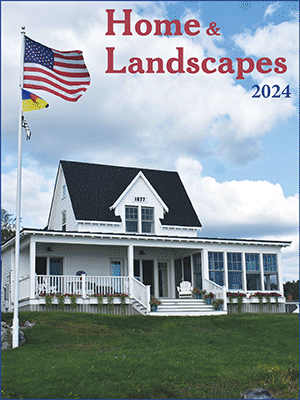Birds and Trails
 Allison took this photo of Jeff and their son years ago during a hike along a trail at Boothbay Region Land Trust's Oven's Mouth Preserve. Courtesy of Allison Wells
Allison took this photo of Jeff and their son years ago during a hike along a trail at Boothbay Region Land Trust's Oven's Mouth Preserve. Courtesy of Allison Wells
 Black-and-white warbler, one of many warbler species easily seen while exploring Maine trails in spring and summer. Courtesy of Jeff Wells
Black-and-white warbler, one of many warbler species easily seen while exploring Maine trails in spring and summer. Courtesy of Jeff Wells
 Brown creeper, a familiar bird more often heard than seen along many of Maine's forested trails. Courtesy of Jeff Wells
Brown creeper, a familiar bird more often heard than seen along many of Maine's forested trails. Courtesy of Jeff Wells
 Allison took this photo of Jeff and their son years ago during a hike along a trail at Boothbay Region Land Trust's Oven's Mouth Preserve. Courtesy of Allison Wells
Allison took this photo of Jeff and their son years ago during a hike along a trail at Boothbay Region Land Trust's Oven's Mouth Preserve. Courtesy of Allison Wells
 Black-and-white warbler, one of many warbler species easily seen while exploring Maine trails in spring and summer. Courtesy of Jeff Wells
Black-and-white warbler, one of many warbler species easily seen while exploring Maine trails in spring and summer. Courtesy of Jeff Wells
 Brown creeper, a familiar bird more often heard than seen along many of Maine's forested trails. Courtesy of Jeff Wells
Brown creeper, a familiar bird more often heard than seen along many of Maine's forested trails. Courtesy of Jeff Wells
There are many ways to enjoy the outdoors. We birders often do that by hiking a trail through a forest, strolling a boardwalk over a bog or marsh, or perhaps scanning an open field or the ocean from a platform or parking lot. If you’re like us, you can quickly think of lots of places where you regularly do all of these things when looking and listening for birds.
But you also may be like us in that you also have many places that you visit that are not so straightforwardly accessible. Perhaps it’s a place that could use a viewing platform to keep people from trampling habitat and to make viewing more enjoyable. Some spots have damaged boardwalks, trails, access roads, or parking lots washed out by heavy rains or high tides. Others may have boardwalks built decades ago that have rotted and become unsteady.
Making such places accessible and safe to visit and explore helps encourage more people to get outside and build a love of birds and other parts of nature. Good ecotourism infrastructure is also an investment that increases local economies by bringing in outdoor enthusiasts who find it easy and fun to visit trails, preserves, and parks.
On Election Day this year, we all will have a chance to help support an initiative to increase funding for the infrastructure for trails of all sorts in Maine. Question Four on the ballot will ask voters if they support a bond to make $30 million dollars available for design, maintenance, and construction of recreational trails over the next four years.
Think of your favorite memories of being outdoors. Most of them probably involve a trail of some kind.
We think of hearing the first high, sweet songs of brown creepers in April along a short woodland trail that extends south from the Gardiner Waterfront. Or smelling the sweet smell of balsam fir and spruce while listening to the buzzy “zee-zee-zoo-zoo-zee” of a black-throated green warbler along the trail at the Oven’s Mouth Preserve of the Boothbay Region Land Trust.
Fondly we remember the spring walk along the Perham Stream Birding Trail in Madrid, Maine, which we wrote about earlier this year where we saw beautiful warblers and an evening grosbeak. We didn’t mention it in the column. There were several places along that trail that could be made more accessible with funding like that proposed in the new Trails Bond.
Not so many years ago, we regularly hiked a boardwalk with our young son on a trail in mid-coast Maine, the smells of salt marsh all around and the calls of yellowlegs echoing across the water. That trail is no longer in existence because of the cost of repair.
Many trails have been damaged by the recent coastal storms that caused so much damage to buildings and roads. These could also be the beneficiaries of funds from the new Trails Bond.
We’re sure you all have similar stories of trails that you love and trails that need funding to remain accessible. Your chance to support the future of those trails is coming this Election Day. We hope you will vote to support the new Trails Bond!
Jeffrey V. Wells, Ph.D., is a Fellow of the Cornell Lab of Ornithology and Vice President of Boreal Conservation for National Audubon. Dr. Wells is one of the nation's leading bird experts and conservation biologists. He is a coauthor of the seminal “Birds of Maine” book and author of the “Birder’s Conservation Handbook.” His grandfather, the late John Chase, was a columnist for the Boothbay Register for many years. Allison Childs Wells, formerly of the Cornell Lab of Ornithology, is a senior director at the Natural Resources Council of Maine, a nonprofit membership organization working statewide to protect the nature of Maine. Both are widely published natural history writers and are the authors of the popular books, “Maine’s Favorite Birds” (Tilbury House) and “Birds of Aruba, Bonaire, and Curaçao: A Site and Field Guide,” (Cornell University Press).


























